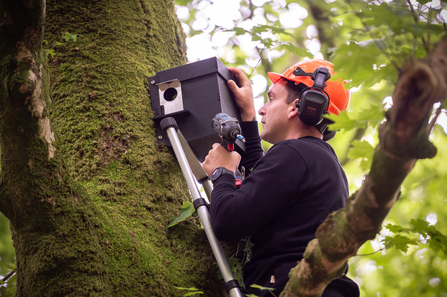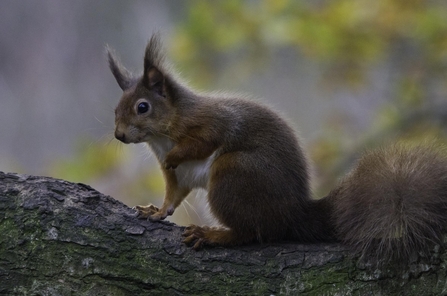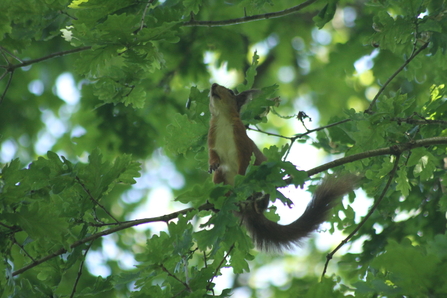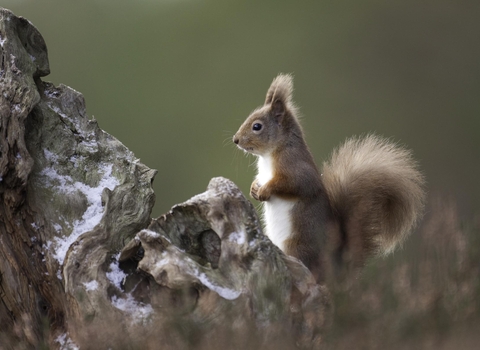
Josh Adams putting up red squirrel nest box with The Cumberland © Harry Atkinson Photography
Providing nests for the endangered animals is just part of conservation work being done by our Red Squirrel Ranger, Joshua Adams. Read more from him below.
Where is this work being carried out?
This project is being conducted in the heart of the Lake District, through many private and public woodlands from the beautiful village of Grasmere through to the heights of Tarn Howes and beyond toward Grizedale and Rusland.
The restoration area covers just under 1000 hectares, and our red squirrel populations can be found dotted all around Cumbria.
Who are the landowners involved?
It's a collaboration between many private land owners, hotel chains and charities such as Cumbria Wildlife Trust and National Trust.
What is the red conservation status of red squirrels?
On the
Josh Adams is the new red squirrel ranger, working for both us and Westmorland Red Squirrels © Cumbria Wildlife Trust
How is it funded?
Funded by Cumberland Building Society and Lakeland Limited, with support from Westmorland Red Squirrels. In April 2023, my role as a Red Squirrel Ranger was created when Cumbria Wildlife Trust embarked on a new project dedicated to protecting the South Lakes Red Squirrel population.
What's the problem?
Red squirrels have been in decline for many years, with pressure from invasive species and suffering from the impacts of habitat loss. It's an uphill struggle to keep remaining red squirrel colonies in place and thriving.
The Eastern grey squirrel, introduced to the UK over 150 years ago, has been a major contributor to the red squirrel decline, carrying a fatal disease that spreads to red squirrels with a 100% mortality rate. Along with food and habitat competition, it truly has taken its toll on red squirrel numbers.
Over all these years, our forests and woodlands have suffered from storm damage, disease such as phytophthora affecting larch, dutch elm and ash die back to name a few. The red squirrel species has found itself displaced to widespread felling of these tree species.

Red squirrel (Sciurus vulgaris) posing on a branch with autumn leaves behind © Bertie Gregory/2020VISION
What did Cumbria Wildlife Trust do?
A large part of Cumbria Wildlife Trust's funding was from Cumberland Building Society’s “mortgages for squirrels” initiative. I was recruited as a ranger to install one hundred red squirrel nest boxes to provide safe shelter for the species from tree felling and storms, with the hope of encouraging red squirrels to stay put and breed.
Along with this, we started several supplementary feeding programs, with a focus on female red squirrels, because breeding female red squirrels must maintain a certain weight or body mass. We encouraged a varied diet of hazelnuts, sunflower seeds, walnuts and peanuts, along with specially designed feeding boxes that keep adult grey squirrels out. The boxes encourage generational skills such as foraging and caching.
Squirrels are expert foragers and don’t stay in the same place all year round; they move with the available food. So to monitor them successfully, I’ve had to move with them. During winter months they rely on their food cache which they store in Autumn, and as spring moves to summer, this is the time when red squirrels really struggle to feed, and this is where our feeding programs work well.
Once summer moves to autumn, they start caching hazel nuts and acorns ready for the winter ahead. During winter reds are very elusive, often staying in their dreys conserving energy. And during summer they are very responsive to food, providing an ideal time for me to monitor and get data on numbers. Its also a great time to see young red squirrel kittens that have emerged from their nests and are getting to grips with their new skills.
We also installed many road signs, as over the years the red squirrel has suffered large losses from road accidents. Raising awareness and erecting road signs on busy roads has hopefully lessened the risk to reds crossing the roads.
What are the benefits of controlling grey squirrel populations?
It must be said that controlling grey squirrels that have been encroaching on red squirrel territory has enormous benefits for the entire woodland.
Trees are no longer damaged by the grey squirrel's habit of “bark stripping”, ground nesting birds can lay eggs without fear of predation and birds, such as tawny owls and woodpeckers, can return to their nesting sites in the trees.
The red squirrel of course benefits the most, being able to store food for winter without risk of it being eaten, and when reds are not under pressure, they breed well, boosting the numbers of red squirrel in the area.

A red squirrel in an oak tree
What other species benefit from red squirrel conservation work?
Many birds and mammals benefit from red squirrel conservation, such as tawny owls, green woodpecker, greater spotted woodpecker, dormice, wood mouse, black bird, red starts, blue tits, great tits, siskin and so many more! Our native tree spices also benefit; that’s the likes of our oaks, hazel, Scots pine, juniper and beech.


